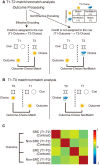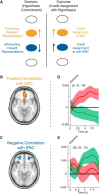Neural Mechanisms of Credit Assignment in a Multicue Environment
- PMID: 26818500
- PMCID: PMC4728719
- DOI: 10.1523/JNEUROSCI.3159-15.2016
Neural Mechanisms of Credit Assignment in a Multicue Environment
Abstract
In complex environments, many potential cues can guide a decision or be assigned responsibility for the outcome of the decision. We know little, however, about how humans and animals select relevant information sources that should guide behavior. We show that subjects solve this relevance selection and credit assignment problem by selecting one cue and its association with a particular outcome as the main focus of a hypothesis. To do this, we examined learning while using a task design that allowed us to estimate the focus of each subject's hypotheses on a trial-by-trial basis. When a prediction is confirmed by the outcome, then credit for the outcome is assigned to that cue rather than an alternative. Activity in medial frontal cortex is associated with the assignment of credit to the cue that is the main focus of the hypothesis. However, when the outcome disconfirms a prediction, the focus shifts between cues, and the credit for the outcome is assigned to an alternative cue. This process of reselection for credit assignment to an alternative cue is associated with lateral orbitofrontal cortex.
Significance statement: Learners should infer which features of environments are predictive of significant events, such as rewards. This "credit assignment" problem is particularly challenging when any of several cues might be predictive. We show that human subjects solve the credit assignment problem by implicitly "hypothesizing" which cue is relevant for predicting subsequent outcomes, and then credit is assigned according to this hypothesis. This process is associated with a distinctive pattern of activity in a part of medial frontal cortex. By contrast, when unexpected outcomes occur, hypotheses are redirected toward alternative cues, and this process is associated with activity in lateral orbitofrontal cortex.
Keywords: decision making; learning; medial prefrontal cortex; orbitofrontal cortex.
Copyright © 2016 Akaishi et al.
Figures










References
Publication types
MeSH terms
Substances
Grants and funding
LinkOut - more resources
Full Text Sources
Other Literature Sources
